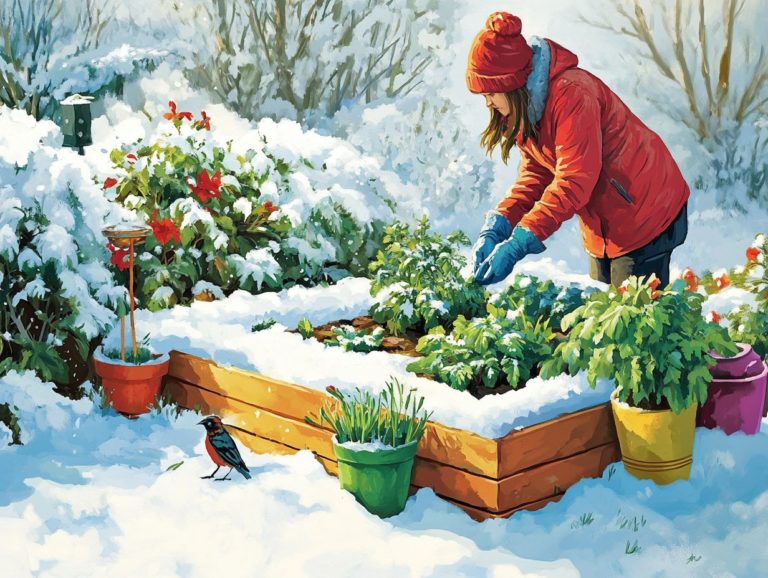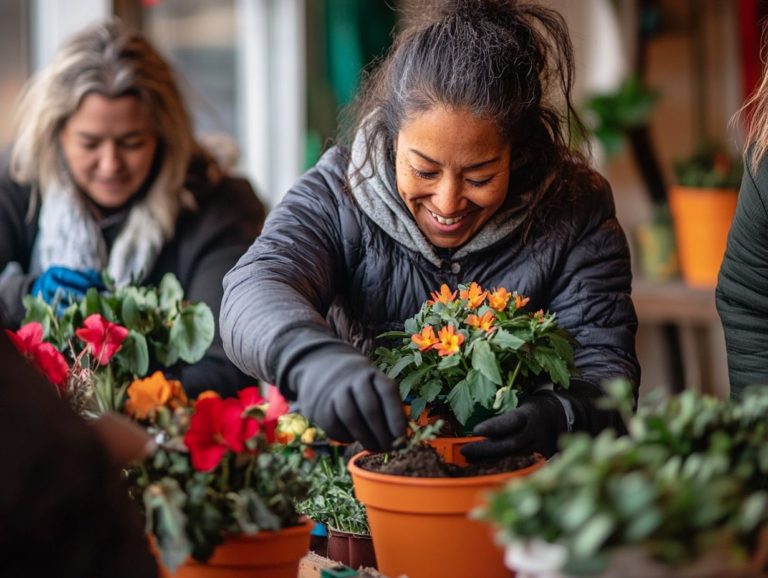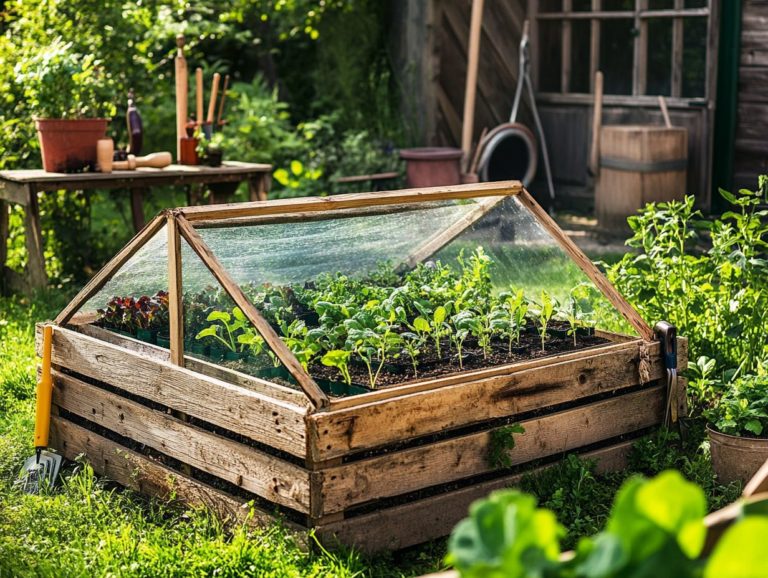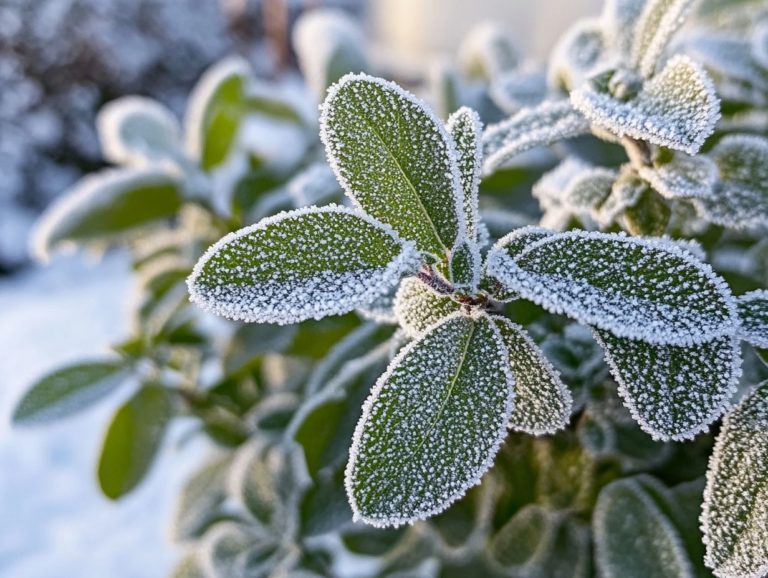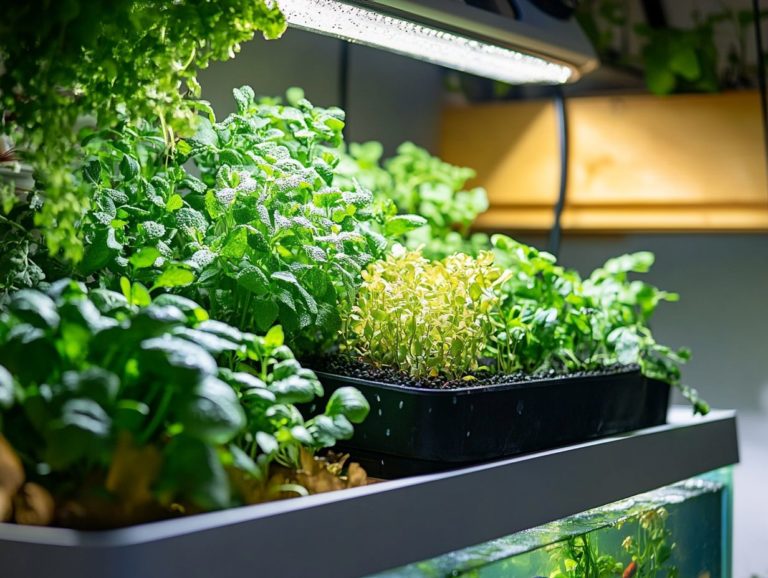Seed Starting for Winter: A Guide
Winter seed starting presents an exceptional opportunity for you to get a head start on the growing season. This enables you to nurture vibrant plants even amidst the chilly months.
This guide reveals amazing benefits of winter sowing, highlighting everything from accelerated plant growth to the prospect of an earlier harvest.
You ll discover how to select the perfect seeds, prepare your gardening space, and provide the care your seedlings need to thrive.
We will also address common challenges you might face while using recycled containers, ensuring that your winter gardening journey is a resounding success.
Gather your supplies now! Transform your winter landscape into a flourishing haven!
Contents
- Key Takeaways:
- Benefits of Starting Seeds in Winter
- Advantages for Plant Growth and Harvest
- Choosing the Right Seeds for Winter
- Preparing for Winter Seed Starting
- Steps for Winter Seed Starting
- Troubleshooting Common Issues
- Frequently Asked Questions
- What is seed starting for winter and why is it important for growing perennials and annuals?
- What supplies do I need for seed starting for winter?
- When should I start seed starting for winter?
- Can I use any seeds for winter seed starting?
- What is the best location for winter seed starting?
- Do I need to water my winter seedlings differently?
Key Takeaways:
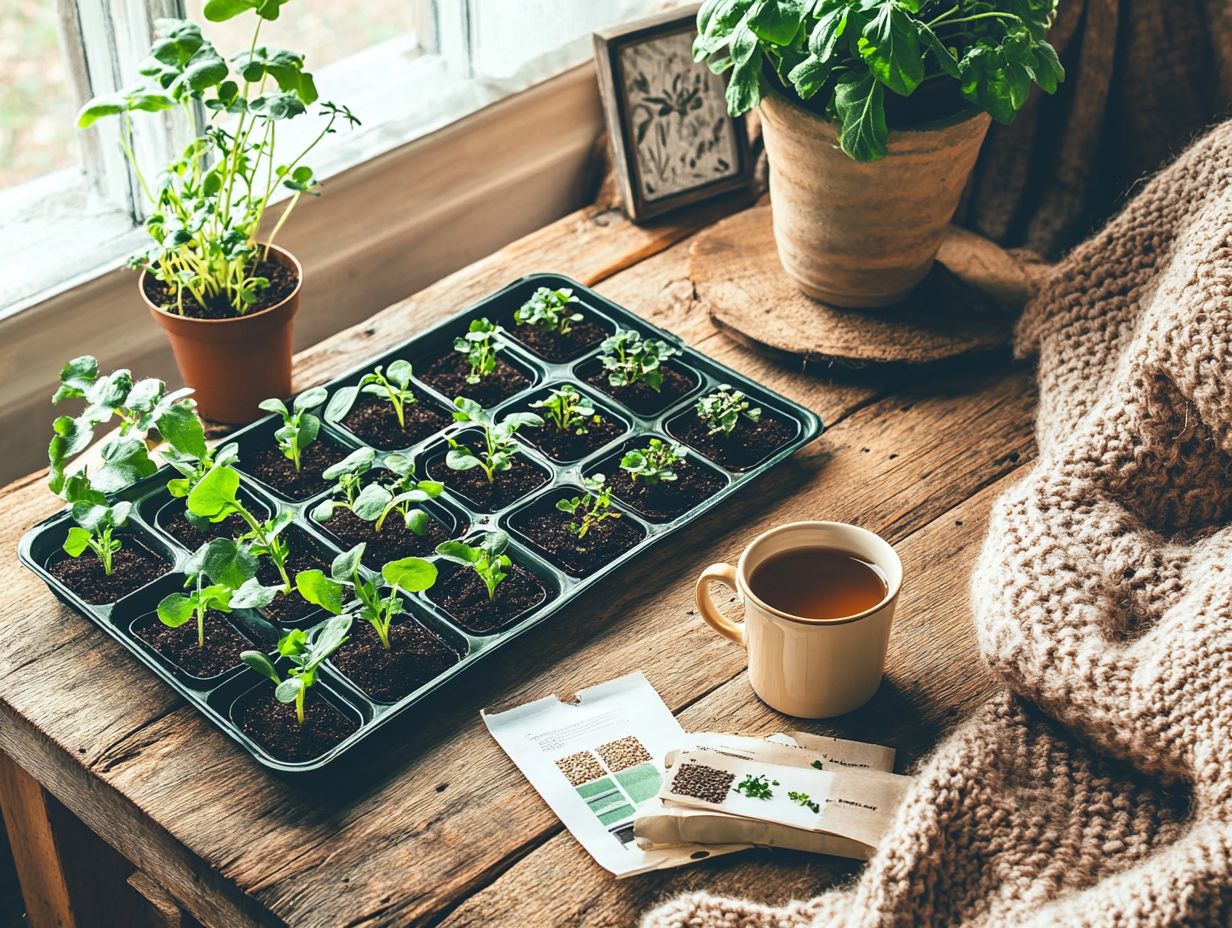
What is Winter Seed Starting?
Winter seed starting is a sophisticated gardening technique that allows you to kick off the seed germination process by harnessing the natural freezing temperatures of winter. For those interested in this method, refer to the essential guide to gardening in cold weather, which ensures your seeds undergo the necessary exposure to cold to germinate, essential for many perennial and annual plants.
By opting for recycled containers like milk jugs or creating mini greenhouses, you can create optimal conditions for seed starting, resulting in healthier seedlings primed for transplanting in the spring. This approach not only conserves space but also expands the variety of seed types you can cultivate, making it an efficient strategy for both novice and seasoned gardeners.
As you embark on winter seed starting, it’s crucial to select containers that can endure the chilling temperatures and moisture levels involved. Milk jugs make an excellent choice due to their durability and size, but remember to ensure they have proper drainage holes to avoid waterlogging, which can lead to unsightly seed rot.
Using high-quality special soil used for planting will provide the essential nutrients your seeds need while promoting adequate aeration. Pay careful attention to planting depth most seeds should be sown about two to three times their width. Ensuring they receive sufficient sunlight, whether through a south-facing window or with grow lights, will significantly enhance their growth.
By focusing on these details, winter seed starting can yield robust seedlings, ready to flourish when spring arrives.
Benefits of Starting Seeds in Winter
Starting seeds in winter offers a wealth of advantages for gardeners eager to elevate their growing potential. You’ll enjoy improved moisture retention and the chance to choose from a broader selection of vegetable and herb seeds that flourish in cooler conditions. To maximize your efforts, consider exploring best practices for winter seeding.
By adopting the winter sowing technique, you can jumpstart your planting season, ensuring that your seeds are primed to germinate as soon as the frost date in spring passes. This thoughtful strategy not only boosts seed germination rates but also fosters healthier growth in seedlings, paving the way for a more bountiful harvest.
Advantages for Plant Growth and Harvest
The advantages of winter sowing are crucial for enhancing plant growth and ensuring a successful harvest. By allowing seeds to germinate naturally according to their growing patterns, you tap into the ideal conditions created by winter s freezing temperatures. This method optimizes your seed germination rates, leading to robust seedlings that are ready for direct transplanting into the garden as soon as spring arrives.
Winter sowing opens the door to cultivating a diverse range of vegetable and herb seeds that might otherwise struggle in warmer climates. This technique is a game changer for hardy plants like kale, spinach, and certain herbs such as cilantro and thyme, which flourish when exposed to cold frames protective structures that keep plants warm during cold weather.
The natural cold stratification process where seeds undergo a period of cold to help them germinate further boosts germination by mimicking the conditions seeds would experience in their native environments. As seed coats gradually break down from frost exposure, the likelihood of successful sprouting increases once temperatures begin to rise, resulting in healthier plants with enhanced resilience.
Winter sowing allows you to jumpstart your growing season, maximizing both the production and overall quality of your harvests while minimizing the need for artificial help.
Choosing the Right Seeds for Winter
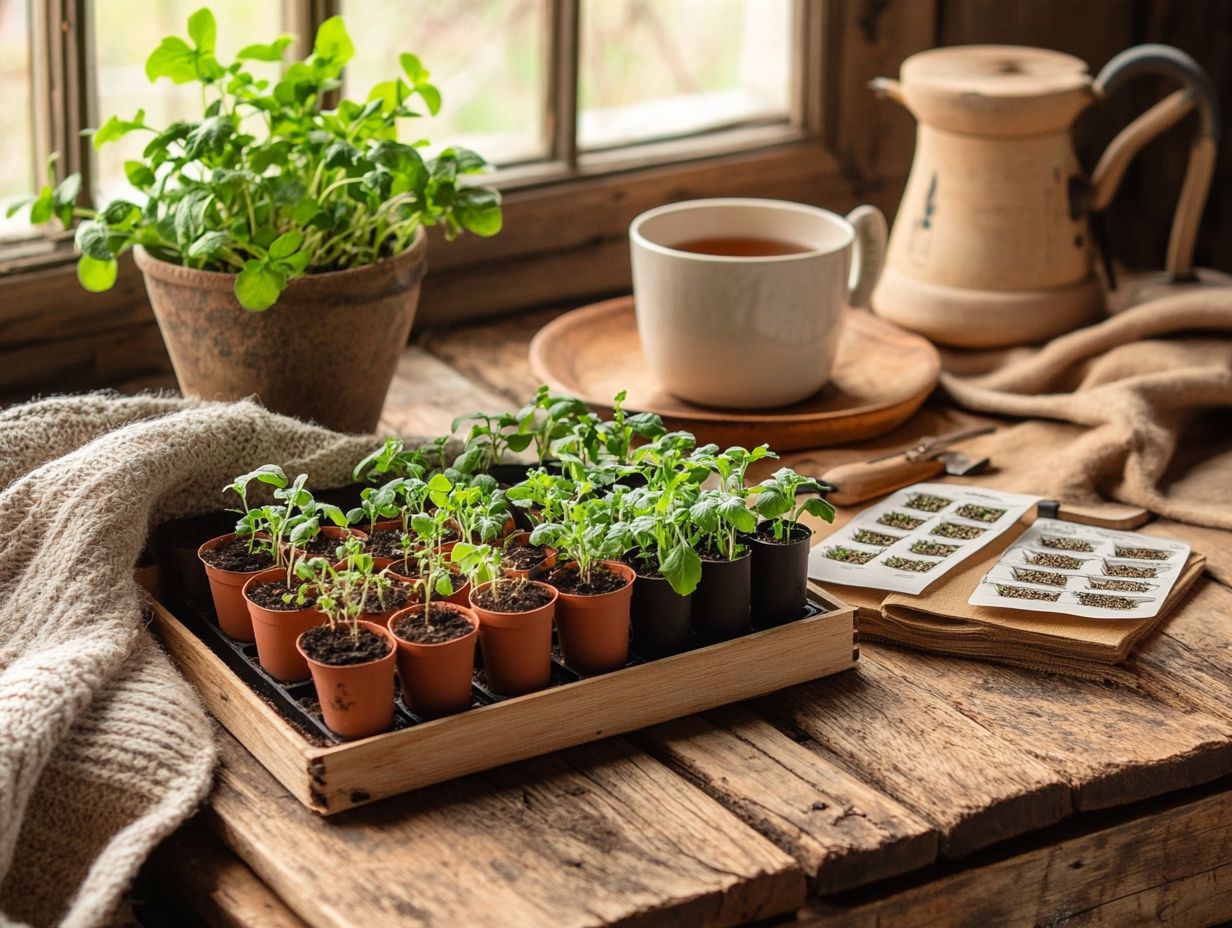
Selecting the ideal seeds for winter sowing is essential for any gardener looking to optimize their yields. For those interested in indoor gardening, exploring tips for growing microgreens in winter can make a significant difference, as certain seed varieties are better suited for colder conditions and specific growing zones, making this choice pivotal.
By grasping the unique requirements of various vegetable and herb seeds, you can craft a collection that not only endures freezing temperatures but also thrives as the soil warms in spring. Thoughtful attention to planting depth and seed types will significantly boost your chances of successful germination and a bountiful harvest.
Types of Plants that Thrive in Winter
Certain types of plants are particularly well-suited for winter sowing, making them your go-to options for the colder months. Think hardy vegetable seeds like kale and broccoli, along with resilient herbs and perennials such as Echinacea.
By selecting these seed varieties, you can ensure that your plants not only survive the winter chill but also thrive when the growing season kicks off. This approach helps you grow a diverse garden that offers both immediate vegetables and enduring perennials.
Alongside these choices, consider winter-friendly options like spinach and carrots, both known for their frost resistance and impressive harvests. For herbs, thyme and parsley are champions of cold tolerance, allowing you to start them early in winter for a bountiful spring.
To foster healthy growth, it s vital to select well-draining soil and guarantee adequate sunlight exposure, even on those shorter winter days. Utilizing cloches or row covers can provide extra protection, while keeping a close eye on moisture levels encourages robust root development as temperatures begin to rise.
Preparing for Winter Seed Starting
Preparing for winter seed starting requires a careful plan to gather essential supplies and create an ideal environment for successful germination and growth, such as following winter-sowing techniques.
You ll want to invest in high-quality potting soil, select containers with adequate drainage holes, and perhaps even gather tools for crafting your own durable DIY containers that can brave the winter elements.
By ensuring that every component is in place, you can cultivate a nurturing atmosphere for your seeds, significantly boosting the chances of vibrant seedlings flourishing come spring.
Gathering Supplies and Setting Up a Space
Gathering the right supplies and creating the perfect space for winter sowing is crucial for successful seed germination and strong growth. Start by selecting quality potting soil that retains moisture while ensuring proper drainage. Using recycled containers minimizes waste and gives your gardening efforts an eco-friendly twist.
Position these containers in spots that receive ample sunlight throughout the winter months. This thoughtful preparation, coupled with the right sunlight exposure, will pave the way for a flourishing garden come spring.
Choose a potting soil mix that strikes the right balance between moisture retention and drainage to prevent root rot. Maintaining this balance is vital during the colder months. You can use plastic, glass, or biodegradable containers as long as they have proper drainage holes for excess water to escape.
To maximize sunlight exposure, place your containers in a southern-facing location or any area that captures the most sun throughout the day. Arranging the containers in a staggered formation can enhance light distribution, ensuring that no seedling is left in the shade. This arrangement promotes even growth, setting you up for a vibrant garden when spring arrives.
Steps for Winter Seed Starting
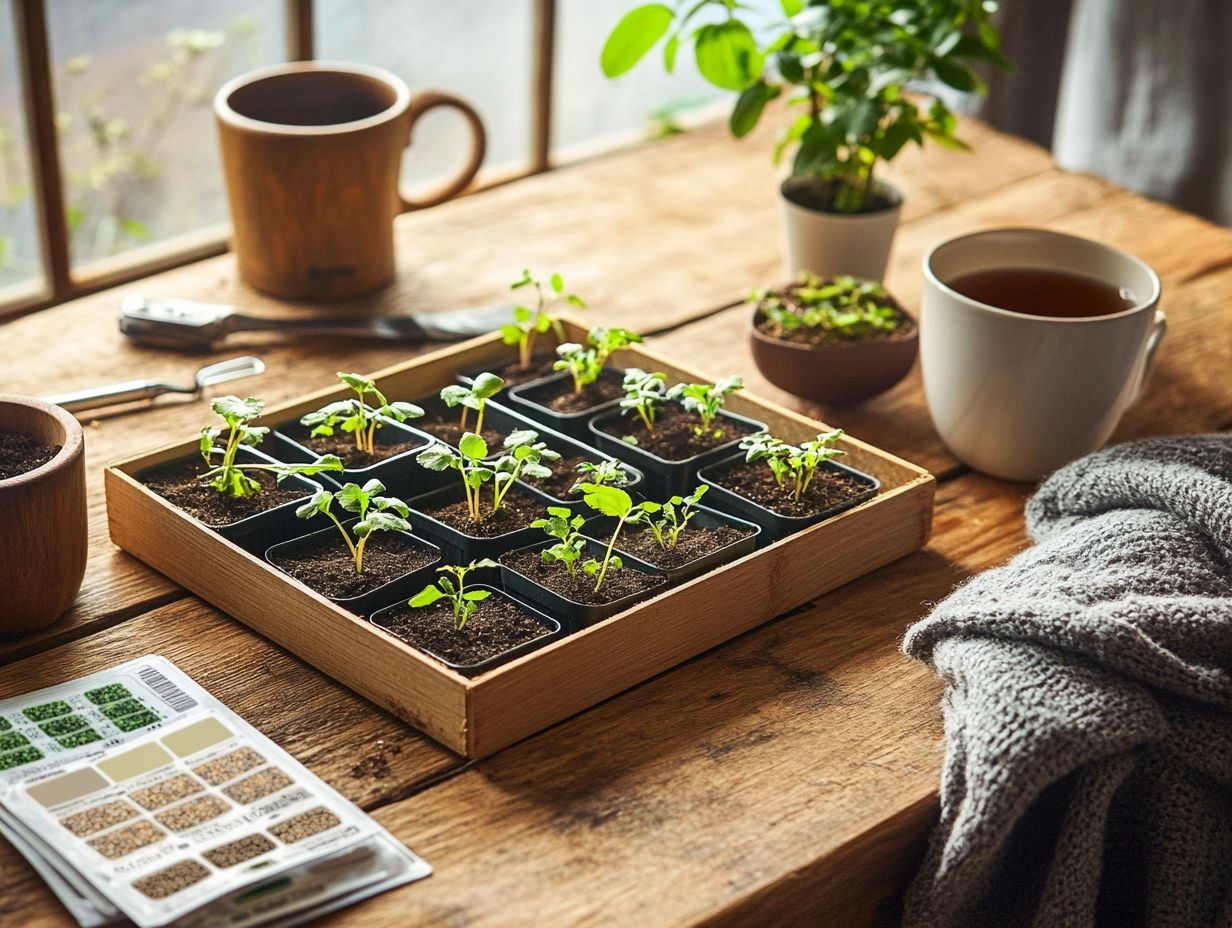
The journey to successful winter seed starting demands a thoughtful approach to sowing seeds and nurturing them through the germination process. For comprehensive strategies, refer to the ultimate guide to winter crop care, which lays the foundation for healthy seedlings ready for later transplantation.
Begin by selecting the most suitable vegetable and herb seeds. Consider essential factors like planting depth and the unique needs of each seed variety. Monitoring conditions such as moisture and sunlight exposure significantly improves your odds of achieving successful seed germination.
Sowing Seeds and Proper Care Techniques
Sowing seeds effectively and implementing proper care techniques are essential for successful winter sowing. Ensure that your seeds are planted at the correct depth while providing adequate moisture and protection from biting winter temperatures.
Start by preparing your containers with high-quality potting soil, then carefully place your seeds, spacing them appropriately. Cover them lightly to promote optimal germination. Regularly monitor moisture levels and environmental conditions to support the healthy growth of your seedlings.
It’s exciting to adopt techniques that foster healthy seedlings! Keeping the soil consistently damp but not waterlogged is key during the germination period. Using clear plastic covers or recycled containers can create a mini-greenhouse effect, aiding in temperature regulation and moisture retention.
As winter progresses, keep an eye out for signs of stress in your seedlings, such as wilting or yellowing leaves, allowing you to intervene promptly. Once temperatures plummet, consider adding protective layers like burlap, duct tape, or frost cloth to shield them from fierce winds and snow, ensuring they thrive until spring arrives.
Troubleshooting Common Issues
Spot problems early to ensure your garden thrives! Troubleshooting common issues during winter sowing is essential for ensuring successful seed germination and fostering healthy growth.
Identifying potential problems like inadequate sunlight exposure, poor moisture retention, or pesky pests helps you navigate setbacks in the seed starting process. Employ effective troubleshooting techniques to significantly enhance your chances of a fruitful transplanting experience come spring.
Preventing and Addressing Problems
Preventing and addressing challenges during winter sowing requires your attention and an active approach. This ensures the best conditions for seed germination and growth.
Be mindful of potential issues like inadequate drainage holes, which are holes in the bottom of pots that let excess water escape. Issues like insufficient sunlight exposure can also stall seed development.
Regular inspections help you catch problems early, paving the way for a successful spring planting of vegetable seeds and herb seeds.
Watch for signs of stunted growth, such as yellowing leaves or leggy seedlings. These can indicate poor light conditions or overcrowding.
Using a mix of well-draining soil is a smart move to tackle drainage issues. Also, rotating or repositioning containers can boost sunlight exposure.
Swift action is key when problems arise. Moving seedlings to a brighter spot or adding more drainage holes can greatly improve their health.
Stay observant and take prompt action to cultivate a thriving winter sowing experience.
Frequently Asked Questions
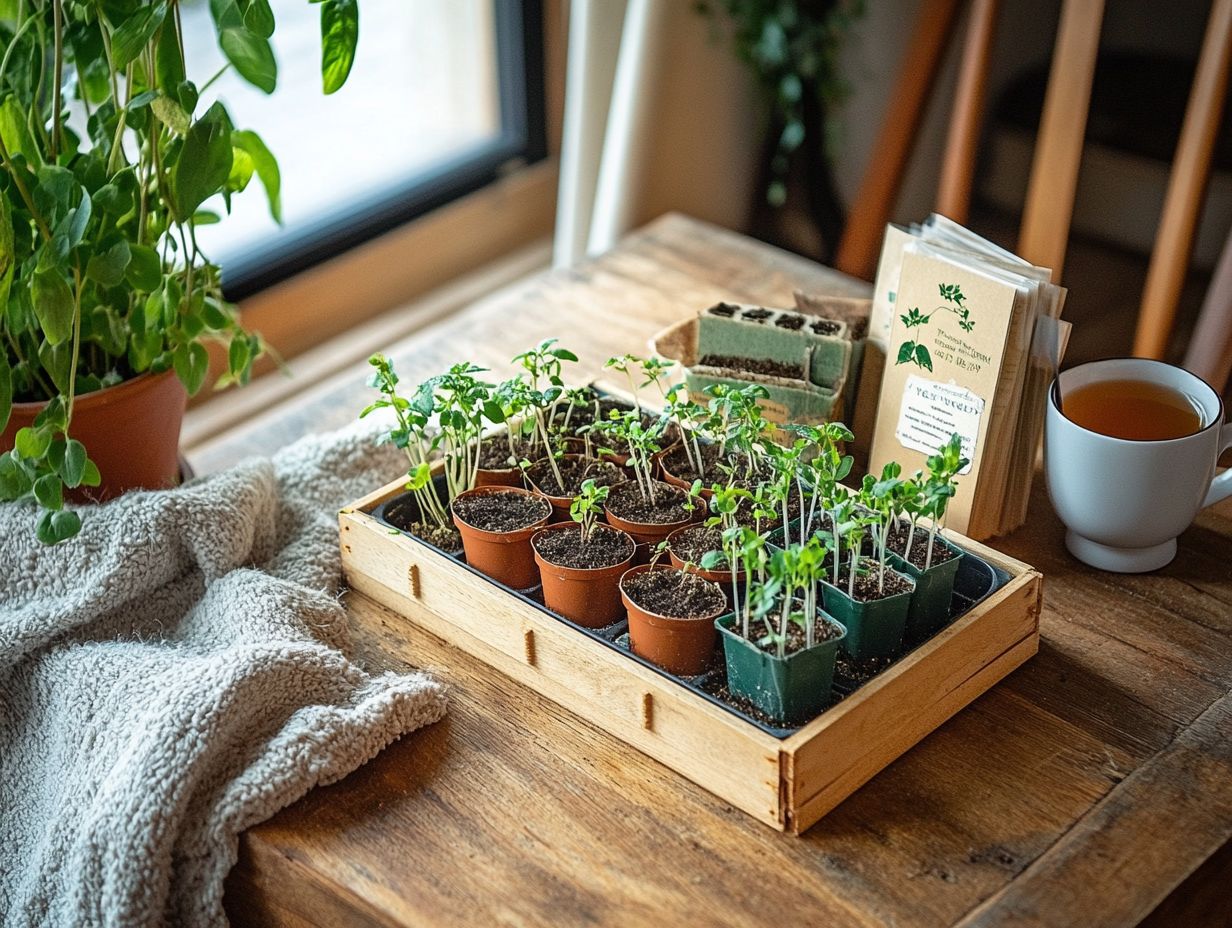
What is seed starting for winter and why is it important for growing perennials and annuals?
Seed starting for winter means planting seeds indoors during colder months. This gives plants a head start for when it’s warm enough to transplant outside, making it crucial to understand winter planting techniques.
What supplies do I need for seed starting for winter?
You will need containers like milk jugs or mini greenhouses, a good quality seed starting mix, seeds, and a light source like a grow light. Optional items include a heating mat, humidity dome, and plant markers.
When should I start seed starting for winter?
Start seeds 6-8 weeks before the last expected frost date in your area. The timing can vary based on location and plant type.
Can I use any seeds for winter seed starting?
Not all seeds work for winter starting. Choose seeds that tolerate cold and are suitable for indoor planting, like lettuce, kale, spinach, and broccoli, following tips for sustainable winter gardening.
What is the best location for winter seed starting?
The ideal spot is warm and sunny, like a south-facing window. If natural light isn t enough, use a grow light for seedlings.
Do I need to water my winter seedlings differently?
Yes, winter seedlings may need more frequent watering due to dry air. Check the soil moisture regularly and avoid overwatering to prevent fungal growth.

